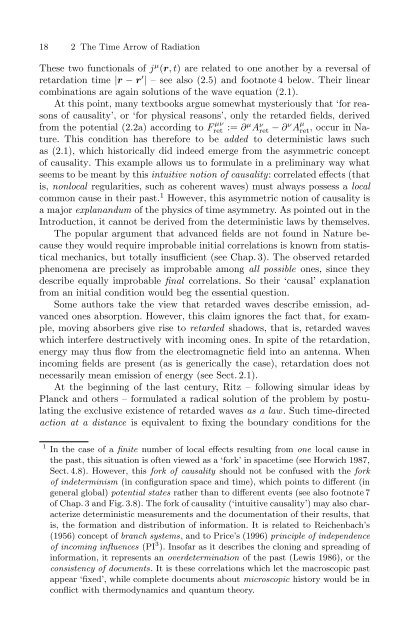The Physical Basis of The Direction of Time (The Frontiers ...
The Physical Basis of The Direction of Time (The Frontiers ...
The Physical Basis of The Direction of Time (The Frontiers ...
Create successful ePaper yourself
Turn your PDF publications into a flip-book with our unique Google optimized e-Paper software.
18 2 <strong>The</strong> <strong>Time</strong> Arrow <strong>of</strong> Radiation<br />
<strong>The</strong>se two functionals <strong>of</strong> j µ (r,t) are related to one another by a reversal <strong>of</strong><br />
retardation time |r − r ′ | – see also (2.5) and footnote 4 below. <strong>The</strong>ir linear<br />
combinations are again solutions <strong>of</strong> the wave equation (2.1).<br />
At this point, many textbooks argue somewhat mysteriously that ‘for reasons<br />
<strong>of</strong> causality’, or ‘for physical reasons’, only the retarded fields, derived<br />
from the potential (2.2a) according to F µν<br />
ret := ∂ µ A ν ret − ∂ ν A µ ret, occur in Nature.<br />
This condition has therefore to be added to deterministic laws such<br />
as (2.1), which historically did indeed emerge from the asymmetric concept<br />
<strong>of</strong> causality. This example allows us to formulate in a preliminary way what<br />
seems to be meant by this intuitive notion <strong>of</strong> causality: correlated effects (that<br />
is, nonlocal regularities, such as coherent waves) must always possess a local<br />
common cause in their past. 1 However, this asymmetric notion <strong>of</strong> causality is<br />
amajorexplanandum <strong>of</strong> the physics <strong>of</strong> time asymmetry. As pointed out in the<br />
Introduction, it cannot be derived from the deterministic laws by themselves.<br />
<strong>The</strong> popular argument that advanced fields are not found in Nature because<br />
they would require improbable initial correlations is known from statistical<br />
mechanics, but totally insufficient (see Chap. 3). <strong>The</strong> observed retarded<br />
phenomena are precisely as improbable among all possible ones, since they<br />
describe equally improbable final correlations. So their ‘causal’ explanation<br />
from an initial condition would beg the essential question.<br />
Some authors take the view that retarded waves describe emission, advanced<br />
ones absorption. However, this claim ignores the fact that, for example,<br />
moving absorbers give rise to retarded shadows, that is, retarded waves<br />
which interfere destructively with incoming ones. In spite <strong>of</strong> the retardation,<br />
energy may thus flow from the electromagnetic field into an antenna. When<br />
incoming fields are present (as is generically the case), retardation does not<br />
necessarily mean emission <strong>of</strong> energy (see Sect. 2.1).<br />
At the beginning <strong>of</strong> the last century, Ritz – following simular ideas by<br />
Planck and others – formulated a radical solution <strong>of</strong> the problem by postulating<br />
the exclusive existence <strong>of</strong> retarded waves as a law. Such time-directed<br />
action at a distance is equivalent to fixing the boundary conditions for the<br />
1 In the case <strong>of</strong> a finite number <strong>of</strong> local effects resulting from one local cause in<br />
the past, this situation is <strong>of</strong>ten viewed as a ‘fork’ in spacetime (see Horwich 1987,<br />
Sect. 4.8). However, this fork <strong>of</strong> causality should not be confused with the fork<br />
<strong>of</strong> indeterminism (in configuration space and time), which points to different (in<br />
general global) potential states rather than to different events (see also footnote 7<br />
<strong>of</strong> Chap. 3 and Fig. 3.8). <strong>The</strong> fork <strong>of</strong> causality (‘intuitive causality’) may also characterize<br />
deterministic measurements and the documentation <strong>of</strong> their results, that<br />
is, the formation and distribution <strong>of</strong> information. It is related to Reichenbach’s<br />
(1956) concept <strong>of</strong> branch systems, and to Price’s (1996) principle <strong>of</strong> independence<br />
<strong>of</strong> incoming influences (PI 3 ). Ins<strong>of</strong>ar as it describes the cloning and spreading <strong>of</strong><br />
information, it represents an overdetermination <strong>of</strong> the past (Lewis 1986), or the<br />
consistency <strong>of</strong> documents. It is these correlations which let the macroscopic past<br />
appear ‘fixed’, while complete documents about microscopic history would be in<br />
conflict with thermodynamics and quantum theory.



![arXiv:1001.0993v1 [hep-ph] 6 Jan 2010](https://img.yumpu.com/51282177/1/190x245/arxiv10010993v1-hep-ph-6-jan-2010.jpg?quality=85)


![arXiv:1008.3907v2 [astro-ph.CO] 1 Nov 2011](https://img.yumpu.com/48909562/1/190x245/arxiv10083907v2-astro-phco-1-nov-2011.jpg?quality=85)








![arXiv:1002.4928v1 [gr-qc] 26 Feb 2010](https://img.yumpu.com/41209516/1/190x245/arxiv10024928v1-gr-qc-26-feb-2010.jpg?quality=85)
![arXiv:1206.2653v1 [astro-ph.CO] 12 Jun 2012](https://img.yumpu.com/39510078/1/190x245/arxiv12062653v1-astro-phco-12-jun-2012.jpg?quality=85)
